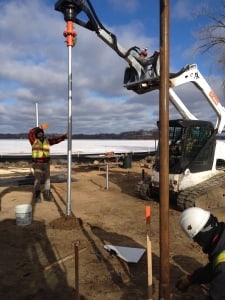Any native or long-time Minnesotan knows this is the land of 10,000 lakes, but it’s also the land of 5,000 marshes, and the land of lots of poor build sites with water-bearing clay, and the land of 4′ deep frost. In other words, you don’t have to look far in Minnesota to find poor, unstable, or “unbuildable” soil conditions.
As custom home builders and remodelors in the West Metro area of the Twin Cities, we’ve seen the effects of these poor soil conditions manifest in a number of ways. We’ve seen deck and porch footings dramatically heaved up out of the ground because of frost’s effect on waterbearing clays. We’ve seen foundations sink and crack and garage floors cave in because of poor compaction or breakdown of organics in the soil. We’ve seen beautiful wetland or lake lots sit vacant and unused because of poor soil conditions. The problems aren’t new, but relatively speaking, many of the solutions available today are new or at least unfamiliar to most.
For standalone footings like ones commonly used for decks or porches, there are “best practices” in place per code that specify how a traditional poured concrete cylindrical footing should be constructed to resist frost movement by enlarging the bottom of the footing and reinforcing the concrete with steel rebar. These are reasonably effective IF the soils are reasonably good (ie. dry clays or sandy mineral soil). In areas with clay soils that get wet and then freeze this “best practice” often isn’t good enough.
Some alternatives to the traditional concrete footing are Diamond Piers (which you can learn more about here) and helical piers among others.
Diamond Piers (shown installed below) are the newest of the technologies mentioned above and have only been on the market locally less than a decade. They are interesting and fairly inexpensive, but not every municipality has approved them to be used in our area yet. If you want to use Diamond Piers in Minnesota (or anywhere else for that matter) do your homework and check with the local permit authority before proceeding.
Helical piers (shown installed below) have been around for over a hundred years, but have only become more widely known within the last 20 years or so. Helical piers are basically a steel pipe or square shaft that has one to four steel plate “helices” welded onto it. The helical pier is screwed into the ground with a hydraulic torque motor. Depending on the weight that needs to be supported and on the soil composition, the helical pier can go as deep as necessary by adding extensions to the lead that has the helices on it. For light structures like a deck or screen porch a single lead is often enough to replace a concrete footing.
Here are some of the benefits of helical piers:
- Can be built on immediately after installation and require no cure time like concrete.
- Cause almost no vibration or disturbance of nearby structures. Can be installed right next to existing foundations without impact.
- Almost no environmental impact. Can be installed in open water or bogs and marshes without worrying about causing harm to water quality or animals.
- Require no digging or soil disposal like traditional footings.
- Invulnerable to frost movement. The helices lock into good soil well below frost depths and the smooth shaft gives frost heaving soils nothing to grab on to.
Helical piers have all the right answers for many of our Minnesota foundation problems, but there is one other consideration that must be mentioned. With small loads and shallow depths helical piers can be competitive with traditional footings, but with heavier loads and greater depths the cost of helical piers can increase dramatically.
If you want more information about helical piers give us a call or check out our helical pier website here. Here are a few more photos of helical piers before and during installation for you to enjoy! :)




